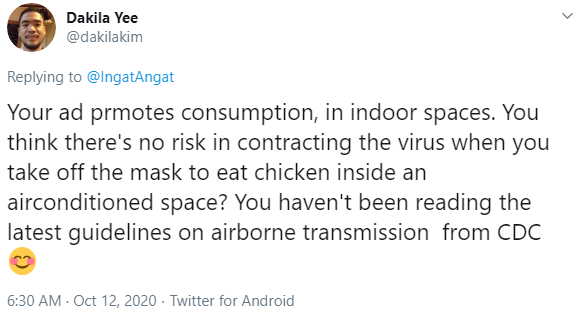A private-led campaign called “Ingat Angat” or “Ingat Angat Tayong Lahat” “that aims to re-start the Philippine economy by empowering Filipinos with vigilance” was perceived as another narrative of romanticizing resilience.
This campaign was launched by Taskforce T3 (Test, Trace, Treat) a multi-sectoral public-private consortium of a few dozen companies and organizations working closely with government agencies tasked to manage the COVID-19 situation in the country.
They also released a two-minute video on social media encouraging the public to resume their daily activities outside their homes while practicing health and safety protocols.
In the clip, various brands and companies which are normally competitors such as Jollibee and McDonald’s; Shell and Petron; Coke and Pepsi; as well as Angkas and Food Panda were featured in scenes where Filipinos work, eat and shop outside.
“Our common goal is to build a more resilient Philippines. A healthy nation in terms of the people and the economy. So we ask all brands and businesses to heed a higher calling for our fellow Filipinos. Together, aangat tayo muli,” the video caption read.
Ingat Angat tayong lahat.
Our common goal is to build a more resilient Philippines. A healthy nation in terms of the people and the economy. So we ask all brands and businesses to heed a higher calling for our fellow Filipinos. Together, aangat tayo muli.#IngatAngat pic.twitter.com/Ix83mZMGzx
— Ingat Angat (@IngatAngat) October 9, 2020
Based on its website, Ingat Angat’s “main goal is to boost the economy by encouraging the public to go out while strongly reminding them to observe safety protocols.”
The T3, on the other hand, was formed in April 2020 and has since partnered with government agencies such as the Department of Health, the National Task Force against COVID-19, and the Inter-Agency Task Force to help manage the novel coronavirus transmissions in the country.
“Ingat Angat is now part of T3’s thrust to build consumer confidence in a bid to slowly revitalize the economy as public health continues to improve,” the group said.
The funds used to fill in the gaps of the health sector such as testing facilities and test kits, meanwhile, were donations from the private companies involved.
How the public received the video
The campaign video released drew mixed reactions from the public.
The comments on the Facebook post was mostly filled with praises, saying how much the video inspired them.
It also earned more than 15,000 reactions where 7,600 were likes and 7,100 were heart emojis.

Its post on Twitter, however, received more critical views.
Anthony Siy, a transport official from Pasig City, denounced the project and called it “weird,” citing the continued surge of COVID-19 infections and lack of guidelines from the health department.
“This is weird and probably a world first. A government that hasn’t issued aerosol transmission guidelines, with daily cases still hovering close to 3,000, telling people to get out of their houses and spend money like it was the old normal. I am in awe,” Siy wrote.
The local official was referring to recent studies stating that the new pathogen is airborne via aerosols or tiny droplets that can linger or float across a space at a longer period of time.
The DOH has yet to recognize the possibility on the new virus being transmitted via air.
One user likewise noted the risks of airborne transmission of COVID-19 in air-conditioned spaces.

In July, Health Undersecretary Maria Rosario Vergeire said there insufficient evidence of airborne transmission of the novel coronavirus.
Aside from concerns on COVID-19 spread, others perceived the campaign video as romanticizing the Filipino resilience anew, which was also often reported during natural disasters such as floods and earthquakes.
RELATED: ‘We smile as one’ tribute video: Resilience, compassion and a classic tune

They also noted that the supposed benefits of going outside depicted in the video were only applicable for the privileged.

One Twitter user specified the lack of Filipino workers who were severely affected by the tough lockdowns in the past months.
“In this video, there were no farmers, fishermen, drivers, informal workers, and blue-collar jobs. People who actually kept the country afloat during the pandemic weren’t given the time of day,” the user said.
Philippines not faring better
The Philippines entered into recession last August wherein the country’s gross domestic product (GDP) growth rate declined by 16.5% in the second quarter of 2020.
This was the lowest GDP growth rate recorded since 1981 or during the Martial law regime.
Data from the Philippine Statistics Authority showed that nearly all major industries had negative growth rates.
In terms of unemployment, PSA stated that the number of Filipinos without jobs eased to 10% last July from 17.7% last April.
However, these figures are still higher than the same period last year, that is, 5.4% in July 2019.









